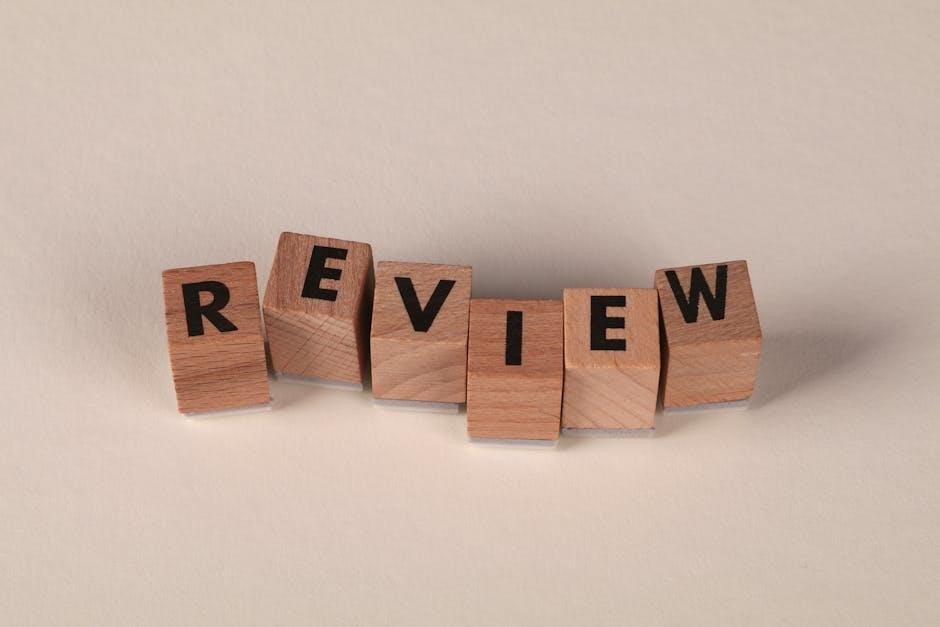An anger management assessment is a formal process to evaluate the underlying causes, severity, and impact of anger-related behaviors․ It helps create tailored strategies for improvement, enhancing emotional well-being and relationships․ PDF formats often provide accessible tools for self-assessment and professional evaluation․
1․1 What is an Anger Management Assessment?
An anger management assessment is a structured evaluation process to identify the nature, severity, and underlying causes of anger-related behaviors․ It helps determine how anger impacts personal and professional life, offering insights into triggers and patterns․ This assessment is often conducted using validated tools, including PDF questionnaires, to provide actionable recommendations for improvement and guide therapeutic interventions․
1․2 Importance of Assessing Anger Management
Assessing anger management is crucial for understanding and addressing anger-related issues․ It helps identify triggers, patterns, and the impact of anger on daily life, enabling the creation of tailored strategies for improvement․ Effective assessment can lead to better relationships, job performance, and overall mental health․ PDF-based assessments provide accessible tools for both self-evaluation and professional intervention, promoting positive behavior change․

Components of an Anger Management Assessment
An anger management assessment typically includes self-report questionnaires, observation, and behavior analysis to identify triggers, patterns, and the impact of anger on daily life and relationships․
2․1 Self-Report Questionnaires and Scales
Self-report questionnaires are essential tools in anger management assessments․ They include standardized scales like the Anger Expression Scale and Anger Control Scale, which measure how individuals experience and manage anger․ These tools help identify patterns, triggers, and the impact of anger on personal relationships and daily functioning․ They provide insights into emotional responses and coping mechanisms, guiding effective intervention strategies․
2․2 Observation and Behavior Analysis
Observation and behavior analysis involve monitoring physical cues, verbal expressions, and actions to assess anger patterns․ Trained professionals evaluate how individuals respond to triggers, identifying escalation signs and coping mechanisms․ This method, combined with self-reports, provides a comprehensive understanding of anger manifestations and their impact on behavior, aiding in developing targeted intervention strategies․
The Role of Anger Management Assessment PDFs
Anger management assessment PDFs provide structured tools for self-evaluation and professional analysis, offering accessible questionnaires and scales to identify anger patterns and develop targeted strategies for improvement․

3․1 Benefits of Using PDF Formats for Assessments
PDF formats offer numerous benefits for anger management assessments, including easy accessibility, compatibility across devices, and the ability to print or fill out forms digitally․ They provide structured questionnaires, ensuring consistency in evaluation․ PDFs are also cost-effective and environmentally friendly, making them a practical choice for both professionals and individuals seeking self-assessment tools․
3․2 Popular Anger Management Assessment Tools in PDF
Popular anger management assessment tools in PDF include self-report questionnaires, anger type identifiers, and structured evaluation forms․ Tools like the Anger Expression Scale and Anger Control Scale are widely used․ Additionally, comprehensive workbooks and checklists are available, offering insights into triggers and coping mechanisms․ These PDF tools are accessible and user-friendly, aiding both professionals and individuals in understanding and managing anger effectively․
How to Conduct an Effective Anger Management Evaluation
Identify triggers, assess the impact of anger on daily life, and analyze behavioral patterns․ Use structured tools to document responses and develop actionable strategies for improvement․
4․1 Identifying Triggers and Patterns of Anger
Identifying triggers involves recognizing situations, people, or events that provoke anger․ Patterns include frequency, duration, and intensity of anger episodes․ Assessments often use questionnaires to uncover these factors, helping individuals understand their anger dynamics․ Recognizing these elements is crucial for developing targeted strategies to manage and reduce anger-related behaviors effectively in daily life․
4․2 Assessing the Impact of Anger on Daily Life
Evaluating how anger affects daily life involves examining its influence on relationships, work, and mental health․ PDF assessments often include questions about interpersonal conflicts, emotional well-being, and behavioral consequences․ This evaluation helps identify areas where anger disrupts functioning, enabling the creation of strategies to mitigate negative impacts and improve overall quality of life through targeted interventions and support․

Strategies for Improving Anger Management
Effective strategies include cognitive-behavioral techniques, relaxation methods, and identifying triggers․ PDF guides often provide exercises to practice self-awareness, emotional regulation, and healthy expression of anger․
5․1 Cognitive Behavioral Therapy (CBT) Techniques
Cognitive Behavioral Therapy (CBT) techniques help individuals identify and challenge negative thought patterns linked to anger․ By learning relaxation methods and assertive communication, people can manage triggers effectively․ CBT strategies, often outlined in anger management assessment PDFs, focus on restructuring harmful beliefs and improving emotional regulation․ This approach enables individuals to recognize and control anger, leading to healthier relationships and personal well-being․
5․2 Relaxation and Coping Mechanisms
Relaxation techniques, such as deep breathing, mindfulness, and physical exercises, help reduce physiological tension caused by anger․ Coping mechanisms, like journaling or time-outs, allow individuals to manage emotions constructively․ These strategies, often detailed in anger management assessment PDFs, encourage healthy emotional expression and prevent escalation․ Regular practice of these methods enhances self-control and promotes a calmer, more balanced response to triggers․

Case Studies and Real-World Applications
Real-world applications of anger management assessments demonstrate their effectiveness in reducing aggression and improving emotional regulation․ Case studies highlight successful outcomes, showcasing how structured programs enhance personal and professional well-being․
6․1 Successful Outcomes of Anger Management Programs
Anger management programs often yield positive results, such as reduced aggression and improved emotional regulation․ Participants frequently report better interpersonal relationships and increased self-control․ These programs empower individuals to identify triggers and develop healthier coping mechanisms, leading to sustainable behavioral changes and enhanced quality of life․
6․2 Common Challenges in Anger Management Assessment
Common challenges include individuals underreporting anger issues due to stigma or lack of self-awareness․ PDF tools may not account for cultural or personal differences, limiting their effectiveness․ Additionally, reliance on self-reporting can lead to inaccurate results․ Ensuring honest responses and tailoring assessments to individual needs remain significant hurdles in achieving reliable anger management evaluations․
The Importance of Self-Assessment in Anger Management

Self-assessment helps individuals identify anger triggers, patterns, and emotional responses, fostering awareness and control․ Worksheets and journals are effective tools for personal growth and behavioral change․
7․1 Using Anger Management Worksheets and Journals
Anger management worksheets and journals are effective tools for tracking emotions and triggers․ They help individuals recognize patterns, develop self-awareness, and document progress․ PDF formats offer structured exercises, prompts, and reflection spaces, making it easier to identify and manage anger constructively․ Regular use fosters accountability and supports long-term behavioral change, enhancing emotional well-being and relationships․
7․2 Setting Personal Goals for Anger Control
Setting personal goals is crucial for effective anger management․ PDF assessments help identify specific objectives, such as reducing outbursts or improving communication․ Goals should be realistic and measurable, allowing individuals to track progress․ Regularly reviewing and adjusting these goals ensures sustained improvement, promoting healthier emotional responses and fostering a more balanced, controlled approach to managing anger in daily life․

Selecting the Right Anger Management Tool
Choosing the right tool involves considering effectiveness, ease of use, and customization․ Popular options like Anger Management Assessment PDFs offer structured frameworks for identifying and addressing anger triggers․
8․1 Factors to Consider When Choosing an Assessment Tool
When selecting an anger management assessment tool, consider its reliability, validity, and ease of use․ Ensure it aligns with the individual’s specific needs, such as identifying triggers or measuring anger control․ The tool should provide actionable insights and be adaptable to different contexts, such as personal or professional settings․ Accessibility and user-friendliness are also key factors to enhance effectiveness․
8․2 Tailoring Assessments to Individual Needs
Anger management assessments should be customized to address individual circumstances, such as personal triggers, emotional responses, and behavioral patterns․ PDF tools allow for flexibility, enabling professionals to adapt questionnaires or exercises to suit specific needs․ This personalized approach ensures that interventions are more effective, fostering better understanding and control of anger in diverse contexts and populations․
Effective anger management begins with a comprehensive assessment, enabling individuals to identify triggers and develop coping strategies․ Utilizing PDF tools ensures accessibility and personalization, fostering long-term behavioral change and emotional well-being․
9․1 Implementing Assessment Results for Better Anger Control
Assessment results provide insights into anger triggers and patterns, enabling targeted interventions․ PDF tools guide the creation of personalized action plans, focusing on CBT techniques, relaxation methods, and goal-setting; Monitoring progress through worksheets and journals ensures accountability and gradual improvement in managing emotions effectively․
9․2 Continuous Improvement and Long-Term Anger Management
Maintaining long-term anger control requires consistent practice and self-reflection․ PDF resources offer ongoing support through exercises and journals, fostering resilience and emotional awareness․ Regular use of these tools helps individuals adapt strategies to life’s challenges, ensuring sustained progress and a healthier approach to managing anger over time․
